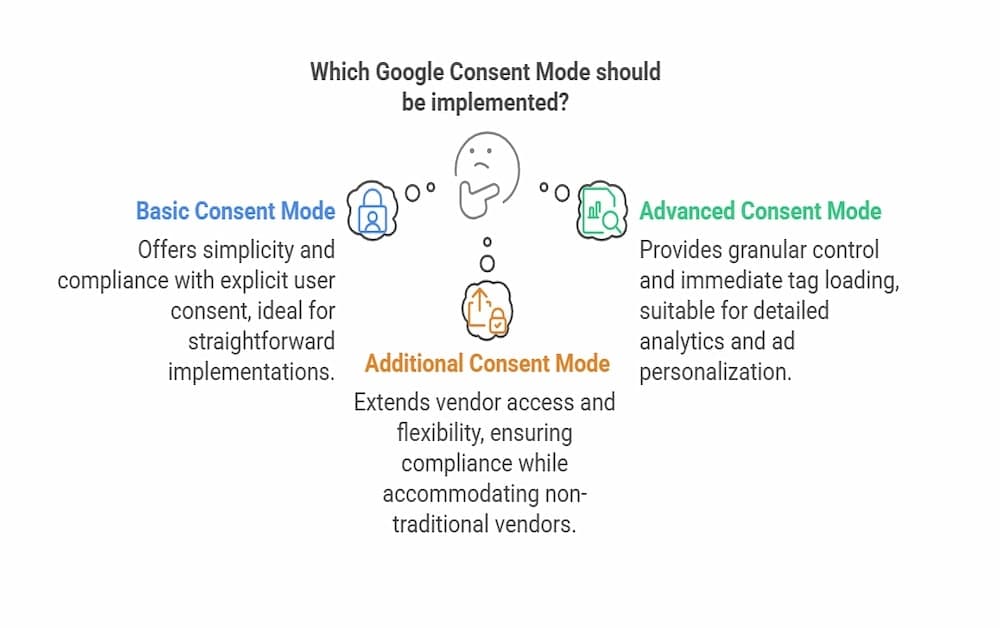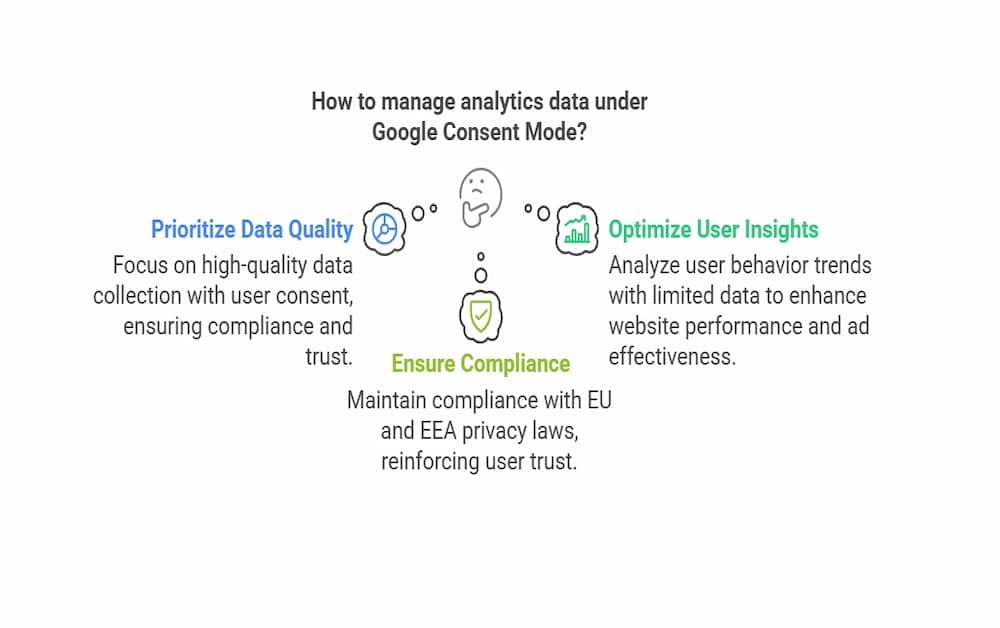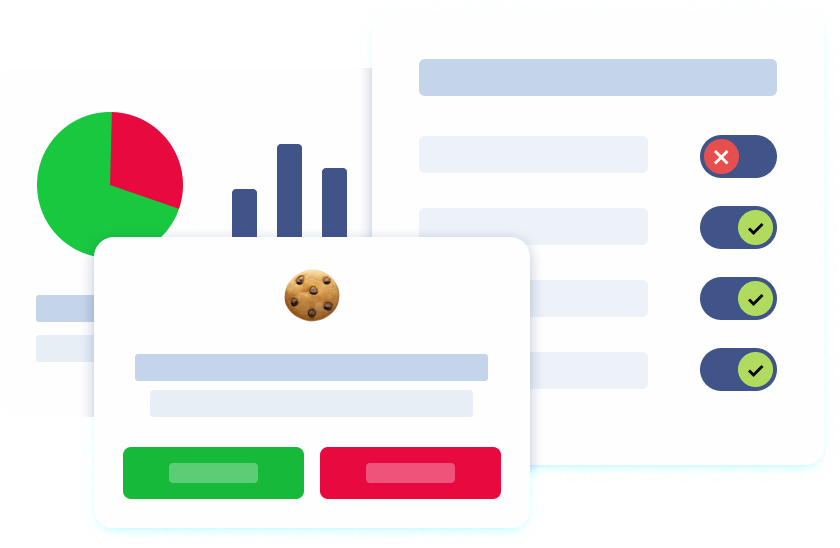Introduction
In today’s digital landscape, ensuring compliance with data protection regulations such as the General Data Protection Regulation (GDPR) and other EU data privacy laws has become paramount. Google Consent Mode represents a revolutionary technical specification designed to help website owners manage user consent, implement consent mode, and protect user privacy. This article delves into Google’s Additional Consent Mode and its basic and advanced variants, explaining how they work with Google Analytics, Google Ads, and other Google services to send consent signals, manage user consent, and transparently align consent requests.
What is Google Consent Mode?
Google Consent Mode is a technical specification that enables websites to adjust how Google tags behave based on the consent status provided by users. It is a key component in ensuring data collection for services like Google Analytics and Google Ads complies with EU and EEA privacy regulations. By using consent signals and the consent mode API, website owners can control when and how data is sent, thereby managing user consent effectively and aligning consent requests with the user’s consent preferences.
Furthermore, Google Consent Mode integrates with consent management platforms (CMPs) to display a consent banner, ensuring that websites adhere to consumer protection laws and privacy policies. This integration supports basic consent mode implementations, where tags are blocked until explicit consent is given, and offers advanced and additional consent modes. Combining these techniques makes it possible to serve ads and collect analytics data while protecting user privacy and honoring the granted consent or denial of consent as determined by the user’s behavior and consent string.
How Google Consent Mode Works
Google Consent Mode uses a set of configurable parameters that transmit users’ consent to Google tags. When users visit a website or app, the consent mode API assesses their choices—whether for advertising, analytics, or other purposes—and adjusts the default consent state accordingly. This mechanism allows Google services to either send or block consent signals based on the user’s decision, ensuring that data collection remains compliant with regulations like the GDPR and IAB Europe’s standards.
The system is built on the principles of flexibility and intelligent data mapping. It supports various scenarios, such as serving targeted ads, ad personalization, and Google Ads conversion tracking, even when users have denied certain types of consent. By sending specific consent signals to vendors and third-party service providers, the framework ensures that each type of Google service—be it Google Analytics or Google Ad Manager—acts in line with the user’s consent preferences. This dual approach of respecting user consent while still capturing necessary data allows website owners to manage consent without sacrificing crucial analytics data and ad revenue.
Key operational features include:
Consent signals: These signals inform Google tags whether to execute or block data collection.
Consent mode API: This API allows for dynamic adjustment of tag behavior based on real-time consent status.
Default consent state: Pre-configured settings that determine the initial behavior of Google services before user input.
These features demonstrate how Google Consent Mode works effectively to maintain compliance with consumer protection laws while allowing website owners to dynamically adjust their data collection practices.

Types of Consent Mode
Google Consent Mode is implemented in three primary forms: Basic Consent Mode, Advanced Consent Mode, and Additional Consent Mode. Each mode serves a different purpose and offers varying levels of granularity and control over user consent, allowing website owners to choose a strategy that aligns with their business needs and privacy policies.
Basic Consent Mode
Basic Consent Mode provides a straightforward method for managing user consent. In this mode, Google tags do not load until a user has interacted with a consent banner. This ensures that data collection does not commence until explicit user consent is received, thereby upholding user privacy and complying with EU data privacy laws. The mechanism behind the basic consent mode is relatively simple—once a user grants consent, the consent mode API allows the tags to load and execute, enabling services such as Google Analytics and Google Ads to function correctly.
The simplicity of Basic Consent Mode lies in its binary approach: if a user denies consent, no data is transferred to Google, and all tags are blocked from firing. This clear-cut distinction protects user privacy and supports ad revenue integrity by ensuring that consent signals to vendors are not sent without explicit permission. Website owners benefit from a clean implementation process, where the technical specification is designed to minimize errors in managing user consent and ensuring that only approved data is collected. Additionally, the mechanism helps avoid accidental data leakage by providing a default consent state that only transitions upon user interaction.
Advantages of Basic Consent Mode include:
Simplicity: Straightforward implementation with clear consent states.
Privacy-first approach: No data is collected until explicit consent is provided.
Compliance: Adheres to stringent EU and EEA privacy laws.
This mode is an excellent option for websites looking to implement a consent management strategy without the need for intricate configurations, making it an ideal starting point for those new to managing consent through Google’s technical specifications.
Advanced Consent Mode
Advanced Consent Mode builds on the foundational aspects of the basic mode by offering more granular control over data collection and tag behavior. In this model, Google tags are loaded immediately when a user opens a website or app, but their behavior is dynamically adjusted based on the user’s consent status. This advanced approach enables a more advertiser-specific model, improving data modeling and analytics outcomes even when users are selective about their consent choices.
One of the key benefits of Advanced Consent Mode is its ability to provide detailed insights into user behavior while still respecting the user’s consent preferences. This is particularly useful for scenarios involving Google Ads conversion tracking and ad personalization, where granular data is critical for optimizing targeted ads and ad revenue. The advanced configuration allows website owners to fine-tune how and when consent signals are sent, thereby enabling third-party service providers and ad tech providers to accurately process analytics data without violating consumer protection laws. This sophisticated approach facilitates intelligent data mapping that is responsive to both granted consent and denied consent scenarios, ensuring that the overall data collection process remains compliant yet effective.
Features of Advanced Consent Mode:
Immediate tag loading: Tags load on user visits, with their behavior later adjusted.
Granular control: Enables more detailed management of consent state and data collection.
Advertiser-specific model: Supports enhanced analytics for targeted ads and conversion tracking.
Advanced Consent Mode is ideal for websites or apps that require more detailed insights into user behavior while ensuring that user consent is managed comprehensively. By integrating this advanced mode, advertisers and publishers can better balance the need for accurate analytics data with the imperative to protect user privacy.
Additional Consent Mode
Google’s Additional Consent Mode is a supplementary technical specification that works alongside the IAB Europe’s Transparency and Consent Framework (TCF) v2.2. This mode explicitly addresses situations where vendors not registered on the IAB Europe’s Global Vendor List, but on Google’s Ad Tech Providers (ATP) list needs to receive consent signals from websites. Additional Consent Mode enables these vendors to obtain consent data, ensuring that even those outside the standard registration processes are aligned with the user’s consent preferences.
The purpose of Additional Consent Mode is to extend the flexibility of managing user consent by providing separate technical specifications for third-party service providers. This allows website owners to implement consent mode in a way that sends consent signals to vendors who otherwise would not be part of the traditional consent framework. In doing so, it bridges the gap between the basic and advanced models by enabling a broader range of ad tech providers and advertisers to receive the necessary consent signals. This mode protects user privacy and helps maximize ad revenue by ensuring that more vendors can participate in data collection and targeted ads—provided that users have granted consent.
Key benefits of Additional Consent Mode include:
Extended vendor access: Allows vendors not registered with IAB Europe to receive consent signals.
Enhanced flexibility: Works alongside existing consent frameworks to offer a comprehensive consent management solution.
Improved compliance: Ensures that even non-traditional vendors adhere to EU data privacy laws and consent standards.
By leveraging Additional Consent Mode, website owners can implement a consent management strategy that is both inclusive and compliant. This advanced approach supports a wide array of Google services—from Google Analytics to Google Ads—ensuring that vendor consent signals are processed accurately according to user consent choices.
Consent Management Platforms (CMPs)
Consent Management Platforms (CMPs) are crucial in implementing Google Consent Mode. A CMP is a tool designed to help website owners manage user consent and deliver a seamless consent banner that integrates with Google’s additional consent mode. These platforms ensure that users have full control over their consent preferences, allowing them to accept or deny using advertising and analytics cookies and other tracking technologies.
By integrating with Google Consent Mode, CMPs facilitate the following benefits:
Streamlined Consent Requests: CMPs help manage consent requests by aligning consent signals with vendors and third-party service providers.
Enhanced Transparency: They provide users with clear options regarding data collection, including options for ad personalization and analytics data gathering.
Compliance with Regulations: CMPs are designed to adhere to consumer protection laws and EU data privacy laws, ensuring that all consent statuses and user behavior are accurately recorded and respected.
In addition, CMPs help website owners implement basic and advanced consent mode configurations. They can dynamically adjust how Google tags load, manage the default consent state and send consent signals based on the user’s consent. This protects user privacy and optimizes ad revenue by ensuring that data collection and targeted ads are only executed after appropriate user consent is obtained. Integrating CMPs with consent mode APIs and additional consent specifications further reinforces the commitment to managing user consent in a compliant and transparent manner.
Pandectes GDPR Compliance & Google Consent Mode
Pandectes GDPR Compliance is a robust and user-friendly consent management platform specifically designed for Shopify stores, helping merchants comply with global privacy regulations such as GDPR and CCPA. Integrating seamlessly with Google Consent Mode allows store owners to dynamically adjust the behavior of Google tags—like those used in Google Analytics and Google Ads—based on users’ consent preferences. This means that data collection can be finely tuned: if a user declines certain cookies, the platform ensures that only non-personally identifiable, modeled data is collected, thereby maintaining accurate insights without compromising user privacy. Ultimately, Pandectes simplifies legal compliance and optimizes digital marketing performance, making it an essential tool for modern e-commerce businesses.

Impact on Analytics Data
The adoption of Google Consent Mode can significantly affect analytics data, especially when users deny consent for advertising and analytics cookies. When a user denies consent, Google tags are prevented from firing, meaning no data is transferred to Google Analytics or other related services. This can reduce the volume of analytics data available for analysis, potentially impacting the accuracy of insights derived from user behavior and ad personalization.
However, despite these limitations, Google Consent Mode also provides a means to collect essential data in a manner that is fully compliant with user consent preferences. For instance, even when advanced consent mode is implemented, specific non-identifiable data may still be collected to support functions like Google Ads conversion tracking and targeted ads. This ensures that website owners can continue to derive meaningful analytics data while respecting the user’s decision regarding data collection. Moreover, the approach facilitates intelligent data mapping and ensures that only consent signals to vendors are processed, thereby preserving user privacy without compromising the quality of analytics insights.
Key considerations for analytics data include:
Data Quality vs. Quantity: While data volume may decrease, the data quality remains high as it is collected with explicit consent.
User Behavior Insights: Even with limited data, trends in user behavior can be analyzed to optimize website performance and serve ads more effectively.
Compliance and Trust: Collecting data in a consent-compliant manner reinforces user trust and supports ongoing compliance with EU and EEA privacy laws.
By understanding the impact of analytics data, website owners can better prepare for scenarios where user consent affects data collection. The key is to balance the need for detailed analytics with the ethical and legal imperatives of managing user consent, ultimately ensuring that ad revenue and targeted ads continue to be optimized while respecting the privacy of EU users.
Conclusion
Google’s Additional Consent Mode and its variations mark a significant advancement in how website owners manage user consent. By using a consent management platform (CMP) with Google Consent Mode, sites can display a responsive consent banner that adjusts data collection based on user consent. This method protects user privacy and complies with GDPR, IAB Europe’s standards, and other laws.
In summary, implementing Google’s Additional Consent Mode along with traditional setups provides website owners with a flexible tool to manage consent preferences and protect analytics data and ad revenue. Whether using the basic approach that halts data collection until consent is given, the advanced model that allows immediate tag loading with later adjustments, or the Additional Consent Mode for non-registered vendors, each model is essential for transparent and compliant data collection. As privacy regulations change, understanding these specifications is key to maintaining user trust in digital advertising.



